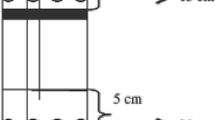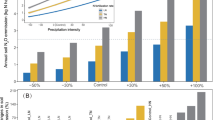Abstract
Many factors are concerned in the changing forms of nitrogen compounds in soil, so it is not easy to make precise models to simulate the concentration profiles of soil nitric oxide (NO) and nitrous oxide (N2O) and their emission rates under various soil conditions. We prepared a simple mathematical simulation model based on soil concentration profiles of NO and N2O. The profiles were measured at lysimeters filled with Andosol soil and fertilized with ammonium sulfate at rate of 200 kgNha-1, incorporating to plow layer (Hirose & Tsuruta, 1996). In this model, diffusion of gases in soil followed Fick's law and the diffusion coefficient was adopted from Sallam et al. (1984). The gas production rate was set up at constant value in the site of gas production, and the gaseous consumption followed Michaelis-Menten kinetics. By changing only the depth of NO and N2O production in soil in this model, we obtained the following results.
(1) When the depth of gas production was set at near the soil surface (NO: 0–10 cm, N2O: 0-8 cm), the emission rates of both gases corresponded with the results of the lysimeter-measurement.
(2) When the depth of gas production was shifted down 10 cm deeper (NO: 10–20 cm, N2O: 10-18 cm), the gas emission rate of NO decreased to 1.3% of (1), while that of N2O was almost the same as (1).
(3) In the case that the total intensity of produced gases was not changed from (1) or (2), but that the extent of gas productions expanded 3 times wider (NO: 0–30 cm, N2O: 0–24 cm) than (1) or (2), the emission rates of NO and N2O became 26% and 95% of (1), respectively.
The above results suggest the possibility of mitigating NO emission by setting the site of gaseous production in deeper soil, e.g. by means of deep application of fertilizer.
Similar content being viewed by others
References
Akiyama H & Tsuruta H (1998) NO & N2O emission from nitrogen fertilized soil (1) – Flux from soil applied by coated urea, urea and (NH4)2SO4 with nitrification inhibitor, and urea and (NH4)2SO4. Res Rep Div Environ Planning NIAES 14: 29–37 (in Japanese)
Akiyama H, Tsuruta H & Hosen Y (1998) NO and N2O emission from nitrogen fertilized soil (2) – Flux from soil applied by coated Ca(NO3)2, Ca(NO3)2, and coated urea. Res Rep Div Environ Planning NIAES 14: 39–45 (in Japanese)
Arah J R M (1992) Modelling the exchange of nitrogen oxides between soils and the atmosphere. Chem Ind 14: 530–532
Ball B C (1981) Pore characteristics of soils from two cultivation experiments as shown by gas diffusivities and permeabilities and air-filled porosities. J Soil Sci 32: 483–498
Breitenbeck G A & Bremner J M (1986) Effects of rate and depth of fertilizer application on emission of nitrous oxide from soil fertilized with anhydrous ammonia. Biol Fertil Soils 2: 201–204
Campbell G S (1985) Soil Physics with BASIC. Elsevier Science Publishers BV, Amsterdam
Currie J A (1965) Diffusion within soil microstructure a structural parameter for soils. J Soil Sci 16: 279–289
Firestone M K & Davidson E A (1989) Microbiological basis of NO and N2O production and consumption, In: Andreae MO & Schimmel DS (eds) Exchange of Trace Gases Between Terrestrial Ecosystems and the Atmosphere, pp 7–21. John Wiley, Chichester
Galbally I E & Johansson C (1989) A model relating laboratory measurements of rates of nitric oxide production and field measurements of nitric oxide emission from soils. J Geophys Res 94: 6473–6480
Granli T & Bø ckman O C (1994) Nitrous oxide from agriculture. Norwegian J. Agric. Sci. Suppl no. 12
Grant R F, Nyborg M & Laidlaw J W (1993a) Evolution of nitrous oxide from soil: I Model development. Soil Sci 156: 259–265
Grant R F, Nyborg M & Laidlaw J W (1993b) Evolution of nitrous oxide from soil: II Experimental results and model testing. Soil Sci 156: 266–277
Hirose T & Tsuruta H (1996) Measurement of NO and N2O fluxes from the soils with the application of ammonium-and nitratefertilizers. Res Rep Div Environ Plannning NIAES 12: 113–118. (in Japanese)
IPCC 1996. Technical Summary. In: Houghton J T, Meira Filho L G, Callander B A, Harris N, Kattenberg A & Maskell K (eds) Climate change 1995 – The Science of Climate Change, pp 9–50. Cambridge Univ Press
Itahashi S, Tsuruta H, Akiyama H, Hosen Y & Eguchi S (1998) NO and N2O emission from nitrogen fertilized soil (3) – Vertical distributions of gas concentrations in soils applied with calcium nitrate, coated calcium nitrate, or coated urea. Res Rep Div Environ Planning NIAES 14: 47–76 (in Japanese)
Johansson C & Galbally I E (1984) Production of nitric oxide in loam under aerobic and anaerobic conditions. Appl Environ Microbiol 47: 1284–1289
Johansson C & Granat L (1984) Emission of nitric oxide from arable land. Tellus 36B: 25–37
Lai S H, Tiedje J M & Erickson A E (1976) In situ measurement of gas diffusion coefficient in soils. Soil Sci Soc Am J 40: 3–6
Li C S, Frolking S & Frolking T A (1992a). A model of nitrous oxide evolution from soil driven by rainfall events: 1 Model structure and sensitivity. J Geophys Res 97(D7): 9759–9776
Li C S, Frolking S & Frolking T A (1992b) A model of nitrous oxide evolution from soil driven by rainfall events: 2 Model applications. J Geophys Res 97(D7): 9777–9783
Li C S, Frolking S & Harriss R C (1994) Modeling nitrous oxide emissions from agriculture: A Florida case study. Chemosphere 28: 1401–1415
Li C S, Narayanan V & Harriss R C (1996) Model estimates of nitrous oxide emissions from agricultural lands in the United States. Global Biogeochem Cycles 10: 297–306
Marshall T J (1959) The diffusion of gases through porous media. J Soil Sci 10: 79–82
Parton W J, Mosier A R & Schimel D S (1988) Rates and pathways of nitrous oxide production in a shortgrass steppe. Biogeochem 6: 45–58
Palmes E D & Tomczyk C (1979) Personal sampler for NOx. Am. Indust Hygiene Assoc J 40: 588–591
Penman H L (1940a) Gas and vapor movements in the soil: I. The diffusion of vapors through porous solids. J Agric Sci 30: 436–462
Penman H L (1940b) Gas and vapor movements in the soil: II. The diffusion of carbon dioxide through porous solids. J Agric Sci 30: 570–581
Pritchard D T & Currie J A (1982) Diffusion coefficients of carbon dioxide, nitrous oxide, ethylene and ethane in air and their measurement. J Soil Sci 33: 175–184
Sallam A, Jury WA & Letey J (1984) Measurement of gas diffusion coefficient under relatively low air-filled porosity. Soil Sci Am J 48: 3–6
Shiozawa A & Ishida T (1988) Water movement in unsaturated soil. In: Personal Computer Guide for Agricultural Civil Engineering. The Japanese Society of Irrigation, Drainage and Reclamation Engineering, Tokyo: 165–176 (in Japanese)
Skiba U, Fowler D & Smith K A (1997) Nitric oxide emission from agricultural soils in temperate and tropical climates: Sources, controls and mitigation options. Nutr Cycl Agroecosyst 48: 139–153
Smith K A & Arah J R M (1992) Measurement and modelling of nitrous oxide emissions from soils. Ecol Bull 42: 116–123
Stefanson R C (1976) Denitrification from nitrogen fertilizer placed at various depths in the soil-plant system. Soil Sci 121: 353–363
Tsuruta H, Yagi K, Hirose T & Araya H (1995) Flux measurements of NO and N2O emitted from soils with the application of urea and slow-release nitrogen fertilizers. Res Rep Div Environ Planning NIAES 11: 49–57 (in Japanese)
Williams E J, Hutchinson G L & Fehsenfeld F C (1992) NOx and N2O emissions from soil. Global Biogeochem Cycles 6: 351–388
Yoh M (1994) Nitrous oxide. In: Minami K (ed) Pedosphere and Atmosphere, pp 85–105. Asakura, Tokyo
Yoh M, Toda H, Kanda K & Tsuruta H (1997) Diffusion analysis of N2O cycling in a fertilized soil. Nutr Cycl in Agroecosyst 49: 29–33
Author information
Authors and Affiliations
Corresponding author
Rights and permissions
About this article
Cite this article
Hosen, Y., Tsuruta, H. & Minami, K. Effects of the depth of NO and N2O productions in soil on their emission rates to the atmosphere: analysis by a simulation model. Nutrient Cycling in Agroecosystems 57, 83–98 (2000). https://doi.org/10.1023/A:1009760220265
Issue Date:
DOI: https://doi.org/10.1023/A:1009760220265




